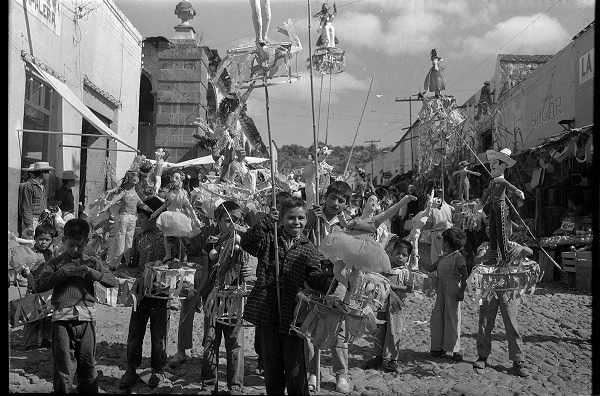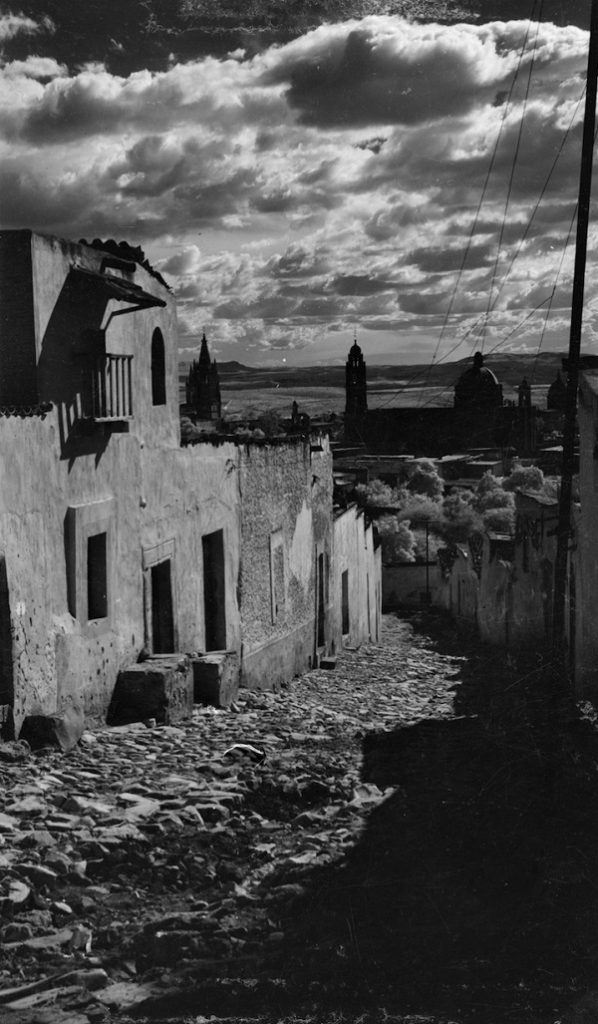By Graciela Cruz Lopez
“The formula to do a good job in photography is to think like a poet”—Imogen Cunningham
Arturo Suárez was born a photographer, artist, and poet. A true scion of his time and his homeland, he was born in San Miguel de Allende in 1910—in the third decade of the 20th century—and left us at the dawn of the 21st century. He lived for 91years.
Through his nine decades, he lived through socially complex situations and historical events: the 400-year celebration of the founding of San Miguel (1942), the founding of Bellas Artes (1937-1939), the arrival of foreigners at the end of the 19th century and first half of the 20th century, construction of the Ignacio Allende Dam (1969), the founding of a new diocese in Celaya, designation of San Miguel’s core zone as an historic area by the federal government (1982), and the designation of the Parroquia as a National and Historical Monument (1944). He was witness to the population growth and urban expansion that occurred from the 1980s. All of this was captured by the subtle, avant-garde, and refined eye of Suárez.
“San Miguel de Allende Through the Eye of Photographer Arturo Suárez” is an exceptional work that is part of the Guanajuato Vive Grandes Historias (Guanajuato Lives Great Histories) collection. It was published by the government of the state of Guanajuato through the Ministry of Tourism, under the direction of Juan Jose Alvarez Brunel. The book is the result of more than two years of hard work, dedication, a summation of will powers, and knowledge. Historian Graciela Cruz López and cultural manager Ernesto Herrera were backed by an interdisciplinary team made up of Marcela Mena, Gabriel Aguilar, Eric Suárez, and Jesús Herrera. They were also aided by the Zona Gráfica, specialists in the art of photography, restoration, cataloging, curatorship, and editorial design.

A biography and 250 historical photographs show the time and work of Suárez. He portrayed the various directions, and significant perspectives of our city, which have undoubtedly changed in form, but not in essence and spirit. All of this remains alive and intact among its original residents, who continue to fight from «San Miguel de adentro» (the inner San Miguel).
The images of Suárez show the border between the historical and the contemporary San Miguel, between what was and what is now. They represent the transitions of a convulsive century, contexts, and perspectives, and define the boundary between what is the city’s own, and what has come from other locales—it is a complex cosmo-vision. His work spreads on a great canvas on which we see the urban layout of the city, its visual highlights, and the harmonious integration of the secular and religious architectural heritage. It shows us the exceptional universal value of San Miguel de Allende, which its residents have guarded for 467 years—values that have been recognized around the world.
Suárez captured the essence of the city’s interior and exterior spaces, every inch and cranny of the walls of centuries-old buildings; they are like living entities, yet immortal, with a unique cultural character and identity. He found the irreplaceable settings, the precise moments, and the most opportune hours, to impart art on everyday life. He was able to capture a provincial light, a defined chiaroscuro, and was able to impart drama into each of his compositions. Through these black and white images, we can imagine and glimpse color, the sense of movement, the depth of the spirit, and the traces and forms of life. He preserves the memory, nostalgia, and remembrance, in custom and tradition, in art and in the roots of the city. This helps us preserve the unique and unrepeatable, generation after generation.

Suárez’s photography brings both continuity and transition; the poet of the lens represents time in different perspectives. His photos are a documentary sources that provide invaluable elements and significant facts of a particular time. Through his work, he gives us a vision of the era in his own way, a dimension of time conceived by man, and by a photographer. He provides an understanding of ruptures and transformations based on historical analysis and research.
Just as great works of humanity have been reinterpreted through timeless ideologies, the works that Suárez produced with his camera are the interpretation of the reality he lived. They are the seed, the foundation, and the inspiration that provide us with a history and give us a broad meaning of this legacy. This photography collection has been safeguarded through two generations by the Suárez Oliden, and Suárez Bustamante families from San Miguel. They will be a necessary reference and a primary source for reflection on the cultural heritage, character, and history of our city. The collection is a window to the past, a reliable document, and contribution to its future.




